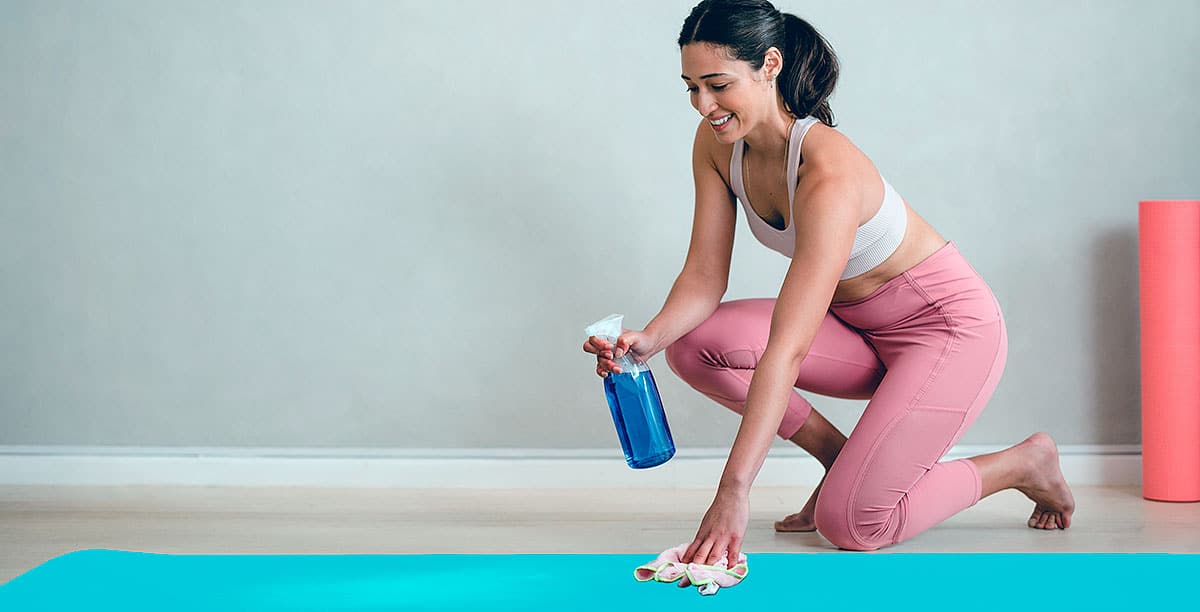So, you just finished a yoga class and now you’re wondering how to keep your yoga mat clean. You don’t have to have one to do yoga poses, but having one supplies cushioning and extra traction to keep your hands from slipping if you get sweaty.
Unfortunately, sweat and oil on a yoga mat also creates a ripe environment for bacteria and other critters that aren’t good for your health. That’s why keeping your mat clean is so important. It’s easy to forget about cleaning it but doing so can make your yoga sessions safer and pleasanter. But how do you keep that yoga mat clean?
A Clean Yoga Mat is a Healthy Yoga Mat
There are a few ways to give that mat a cleaning. The first way is by wiping it down with water after each use. You can also use a diluted soap solution to clean up your mat after a yoga session. To do this, mix 4 drops of dish soap with 2 cups of water and place it in a spray bottle.
Also available are wipes and solutions made for cleaning yoga mats. However, those are drying to the mat and could shorten its lifespan if you use them too often. It’s best to use a water-based cleaner if you wipe your mat down after each class.
Another natural alternative, and the least expensive, is to use a mixture of vinegar and water. Mix one part white vinegar with 4 parts of water. Place the dilute solution in a spray bottle and keep it handy for regular cleaning. A homemade vinegar cleaner has advantages over commercial cleaners. Vinegar has antibacterial properties, and it isn’t unhealthy to breathe in its fumes, unlike the chemicals in some cleaning products.
You can also add a drop or two of tea tree oil to your vinegar solution since it has anti-bacterial properties. Be sure to clean both sides of the mat. Some people clean only the side they’re lying on and forget about the other side. If you’re wiping your yoga mat with a damp towel, remove all excess water with a dry towel to discourage mold growth.
Why Cleaning a Yoga Mat is So Important
Not convinced you need to clean your yoga mat? This might change your mind. An article on yogajournal.com discussed the case of a woman’s yoga mat that cultured 12 million counts of bacteria.
Why are yoga mats so infested with bacteria? Think about it. You stand, sit, and lie on your yoga mat and when you don’t clean your mat, it can foster fungi that cause athlete’s foot and viruses that cause plantar warts and ringworm. Yoga mats are porous and trap bacteria, germs, dust, and dead skin cells among other things. Yuck!
Cleaning your mat can also extend its useful lifespan. A clean mat is a healthy mat, and a healthy mat keeps you from getting sick and missing too many classes. Yoga is one of the best stress relievers around, and you don’t want to miss out on that because of a dirty yoga mat. You’re doing yoga to improve your health, so make sure you’re not jeopardizing it in another way by not cleaning your mat.
How Often You Should Clean Your Yoga Mat?
Give your yoga mat a cleanup with a dilute vinegar solution every time you use it. This will help reduce the growth of mold, viruses, fungi, and bacteria. If your mat smells funky or feels sticky after use, that’s a good sign you need to clean your mat more often.
Some people use a dilute bleach solution to clean yoga mats, but that’s not a healthy practice. Even a dilute bleach solution can cause eye and throat irritation, and long-term exposure to bleach can be harmful to your health. Never spray solutions that contain bleach in an enclosed space or mix bleach with other chemicals.
What about a Deep Clean?
Can you wash a yoga mat in a washer? Yes, but wash it alone, not with other clothing, and avoid using the spin cycle since that can damage the mat. Also, don’t place it in a tumble dryer. Instead, hang it over a chair in a non-humid room–not the bathroom–so it can air dry.
What if You Take a Yoga Class?
Although it might be tempting to use the yoga mat that a studio provides, it’s riskier than bringing your own. It’s not uncommon for ringworm to grow on dirty yoga mats. So be safe and carry your own mat to class. It’s not worth the risk. Also, don’t share your yoga mat with other people.
The Bottom Line
Bacteria, yeast, and fungi love to feast on the sweat and dead skin cells that accumulate on your yoga mat. That’s why cleanliness matters for a better yoga experience and for your health. Having a clean yoga mat will add to the “flow” of the experience and help you avoid hindrances like athlete’s foot. Take a little time to clean up your mat. You’ll be glad you did and you might have that yoga mat around longer too.
References:
- com “Beware of Germs”
- com. “The Ultimate Guide to Cleaning Your Yoga Mat”
- Environmental ResearchVolume 165, August 2018, Pages 81-90
- com. “Here’s Exactly How to Clean Your Yoga Mat”
- com. “Should you wipe down your gym yoga mat to avoid germs?”
Related Articles By Cathe:
An Overview of Yoga Styles That You Often See Advertised
Can the Practice of Yoga Slow Brain Aging?
Yoga and Aerobic Exercise Are Synergistic for Heart Health
Does Yoga Improve Bone Health?
Can Yoga Be a Cardiovascular Workout?
Is a Yoga Workout Effective for Building Strength?
Does Yoga Help With Weight Loss?
4 Benefits of a Relaxing Yoga Workout if You Do High-Intensity Exercise
Cathe Fitness Accessories
Cathe Yoga Mats (purchase directly from us at our Shop.Cathe website)
Cathe Yoga Mats on Amazon (you can also purchase our Yoga & Exercise mats from our Amazon store)


